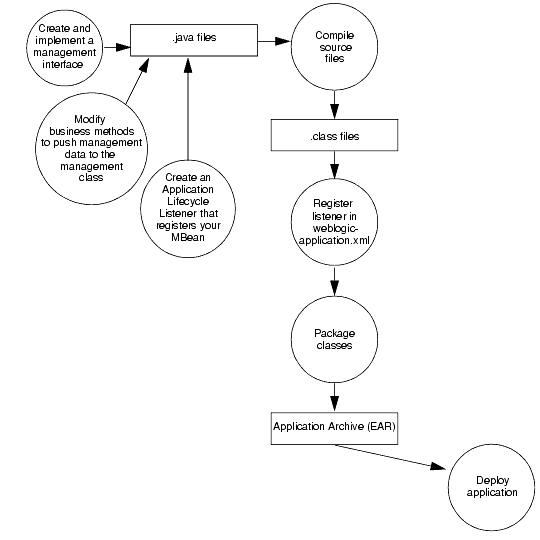Developing Manageable Applications with JMX
|
|
Instrumenting and Registering Custom MBeans
This section describes BEA's recommendation for instrumenting and registering standard MBeans for application modules. Figure 4-1 illustrates the process. The steps in the process, and the results of each are described in Table 4-1. Subsequent sections detail each step in the process.
Figure 4-1 Standard MBean Development Overview
Create and Implement a Management Interface
One of the main advantages to the standard MBeans design pattern is that you define and implement management properties (attributes) as you would any Java property (using getter/is and setter methods); similarly, you define and implement management methods (operations) as you would any Java method.
When you register the MBean, the MBean server examines the MBean interface and determines how to represent the data to JMX clients. Then, JMX clients use the MBeanServerConnection.getAttribute() and setAttribute() methods to get and set the values of attributes in your MBean and they use MBeanServerConnection.invoke() to invoke its operations. See MBeanServerConnection in the J2SE 5.0 API Specification.
To create an interface for your standard MBean:
where
Business-objectis the object that is being managed.BEA's recommended design pattern for standard MBeans enables you to follow whatever naming convention you prefer. In other standard MBean design patterns (patterns in which the MBean's implementation file does not extend
javax.management.StandardMBean), the file name must follow this pattern:Impl-fileMBean.javawhereImpl-fileis the name of the MBean's implementation file.- For each read-write attribute that you want to make available in your MBean, define a getter and setter method that follows this naming pattern:
getAttribute-namesetAttribute-namewhere
Attribute-nameis a case-sensitive name that you want to expose to JMX clients.If your coding conventions prefer that you use an
isAttribute-nameas the getter method for attributes of typeBoolean, you may do so. However, JMX clients use theMBeanServerConnection.getAttribute()method to retrieve an attribute's value regardless of the attribute's data type; there is noMBeanServerConnection.isAttribute()method.
Listing 4-1 is an MBean interface that defines a read-only attribute of type int and an operation that JMX clients can use to set the value of the attribute to 0.
Listing 4-1 Management Interface
package com.bea.medrec.controller;
public interface RecordSessionEJBMBean {
public int getTotalRx();
public void resetTotalRx();
}
BEA recommends the following pattern as a naming convention for implementation files:
MBean-InterfaceImpl.java.See
StandardMBeanin the J2SE 5.0 API Specification.With BEA's recommended design pattern in which you separate the management logic into a delegate class, you must provide a public constructor that implements the
StandardMBean(Object implementation, Class mbeanInterface)constructor.- If you are using BEA's recommend design pattern in which business objects push management data into the management object, provide a method in this implementation class that the business methods use to set the value of the management attribute. In Listing 4-2, the
incrementTotalRx()method is available to business methods but it is not part of the management interface. - If multiple instances of an EJB, servlet, or other class can set the value of a management attribute, make sure to increment the property atomically and do not make its getter and setter (or increment method) synchronized. While synchronizing guarantees the accuracy of management data, it blocks business threads until the management operation has completed.
Listing 4-2 MBean Implementation
package com.bea.medrec.controller;
import javax.management.StandardMBean;
import com.bea.medrec.controller.RecordSessionEJBMBean;
public class RecordSessionEJBMBeanImpl extends StandardMBean
implements RecordSessionEJBMBean {
public RecordSessionEJBMBeanImpl() throws
javax.management.NotCompliantMBeanException {
super(RecordSessionEJBMBean.class);
}
public int TotalRx = 0;
public int getTotalRx() {
return TotalRx;
}
public void incrementTotalRx() {
TotalRx++;
}
public void resetTotalRx() {
TotalRx = 0;
}
}
Modify Business Methods to Push Data
If your management attributes contain data about the number of times a business method has been invoked, or if you want management attributes to contain the same value as a business property, modify your business methods to push (update) data into the management implementation class.
Listing 4-3 shows a method in an EJB that increments the integer in the TotalRx property each time the method is invoked.
Listing 4-3 EJB Method That Increments the Management Attribute
private Collection addRxs(Collection rXs, RecordLocal recordLocal)
throws CreateException, Exception {
...
com.bea.medrec.controller.RecordSessionEJBMBeanImpl.incrementTotalRx();
...
}
Register the MBean
If you want to instantiate your MBeans as part of application deployment, create an ApplicationLifecycleListener that registers your MBean when the application deploys (see Use ApplicationLifecycleListener to Register Application MBeans):
- In this
ApplicationLifecycleListenerclass, implement theApplicationLifecycleListener.postStart(ApplicationLifecycleEvent evt)method. BEA recommends this naming convention:
your.company:Name=Parent-module,Type=MBean-interface-classnameTo get the name of the parent module, use
ApplicationLifecycleEventto get anApplicationContextobject. Then useApplicationContextto get the module's identification.If the classes for the JMX client are part of a J2EE module, such as an EJB or Web application, then the JNDI name for the Runtime MBeanServer is:
java:comp/env/jmx/runtimeIf the classes for the JMX client are not part of a J2EE module, then the JNDI name for the Runtime MBean Server is:
java:comp/jmx/runtimeInitialContext ctx = new InitialContext();
MBeanServer server = (MBeanServer)
ctx.lookup("java:comp/env/jmx/runtime");See Make Local Connections to the Runtime MBean Server in Developing Custom Management Utilities with JMX.
When your application deploys, the WebLogic deployment service emits
ApplicationLifecycleEventnotifications to all of its registered listeners. When the listener receives apostStartnotification, it invokes itspostStartmethod. See Programming Application Lifecycle Events in Developing Applications with WebLogic Server.- In the same class, implement the
ApplicationLifecycleListener.preStop(ApplicationLifecycleEvent evt)method.
For an example of this technique, see the Medrec example server.
Package Application and MBean Classes
Package your MBean classes in the application's APP-INF directory or in a module's JAR, WAR or other type of archive file depending on the access that you want to enable for the MBean. See Additional Design Considerations.
